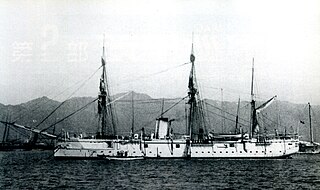Several ships have been named Musashi (武蔵):

A torpedo boat is a relatively small and fast naval ship designed to carry torpedoes into battle. The first designs were steam-powered craft dedicated to ramming enemy ships with explosive spar torpedoes. Later evolutions launched variants of self-propelled Whitehead torpedoes.

Musashi (武蔵), named after the former Japanese province, was one of three Yamato-class battleships built for the Imperial Japanese Navy (IJN), beginning in the late 1930s. The Yamato-class ships were the heaviest and most powerfully armed battleships ever constructed, displacing almost 72,000 long tons (73,000 t) fully loaded and armed with nine 46-centimetre (18.1 in) main guns. Their secondary armament consisted of four 15.5-centimetre (6.1 in) triple-gun turrets formerly used by the Mogami-class cruisers. They were equipped with six or seven floatplanes to conduct reconnaissance.

The Imperial Japanese Navy was the navy of the Empire of Japan from 1868 to 1945, when it was dissolved following Japan's surrender in World War II. The Japan Maritime Self-Defense Force (JMSDF) was formed between 1952–1954 after the dissolution of the IJN.

A warship or combatant ship is a naval ship that is built and primarily intended for naval warfare. Usually they belong to the armed forces of a state. As well as being armed, warships are designed to withstand damage and are usually faster and more maneuverable than merchant ships. Unlike a merchant ship, which carries cargo, a warship typically carries only weapons, ammunition and supplies for its crew. Warships usually belong to a navy, though they have also been operated by individuals, cooperatives and corporations.

Steam frigates, the larger steam ships of the line and the smaller steam corvettes, steam sloops, steam gunboats and steam schooners, were steam-powered warships that were not meant to stand in the line of battle. The first such ships were paddle steamers. Later on the invention of screw propulsion enabled construction of steam-powered versions of the traditional ships of the line, frigates, corvettes, sloops and gunboats.
Two ships in service with the Imperial Japanese Navy were named Yamato:

The Yamato-class battleships were two battleships of the Imperial Japanese Navy (IJN), Yamato and Musashi, laid down leading up to World War II and completed as designed. A third hull laid down in 1940 was converted to an aircraft carrier, Shinano, during construction.
The name Musashi (武蔵) has been borne by three ships of the Japanese Navy and may refer to:

Yamato was the second vessel in the Katsuragi class of three composite hulled, sail-and-steam corvettes of the early Imperial Japanese Navy. It was named for Yamato province, the old name for Nara prefecture and the historic heartland of Japan. The name was used again for the World War II battleship Yamato, commissioned in 1941.

Musashi (武蔵) was the third and final vessel in the Katsuragi class of composite hulled, sail-and-steam corvettes of the early Imperial Japanese Navy. It was named for Musashi province, a former province of Japan located in the Kantō region. The name was used again for the more famous World War II battleship Musashi.

Kashino (樫野) was a unique ammunition ship operated by the Imperial Japanese Navy from 1940 until she was sunk by a United States Navy submarine in 1942. She was built to carry the Yamato-class battleship's main battery from the Kure Naval Arsenal to the shipyards where the battleships were being constructed. When the ships were completed, Kashino was converted to carry ammunition and other supplies.

Tosa (土佐) was a planned battleship of the Imperial Japanese Navy. Designed by Yuzuru Hiraga, she was envisioned as the lead ship of the Tosa class of two 39,900-long-ton (40,540 t) ships. The battleships would have been armed with ten 410 mm (16.1 in) guns and bring Japan closer to its goal of an "Eight-four" fleet. However, after the Washington Naval Conference and the signing of the Washington Naval Treaty, all work on the ship was halted. With the vessel required to be destroyed in accordance with the terms of the treaty, the incomplete Tosa was then subjected to various tests to gauge the effect of Japanese weaponry before being scuttled on 9 February 1925.
Several ships have been named Takao (高雄):

The Katsuragi class was a three-ship class of composite hulled, sail-and-steam corvettes of the early Imperial Japanese Navy.
Gremyashchy can refer to a number of Russian or Soviet warships:
At least three warships of Japan have been named Hiei, after Mount Hiei:
Three Japanese warships have borne the name Tenryū: